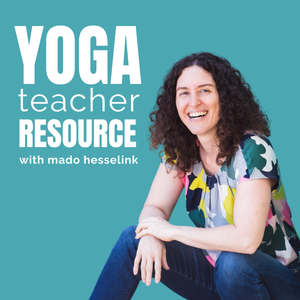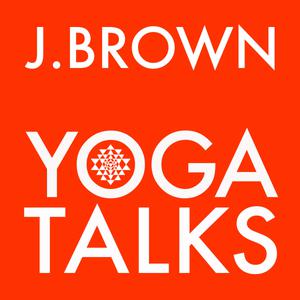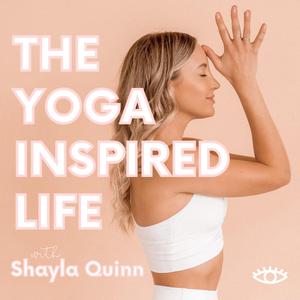
Yoga Teacher Resource Podcast
Mado Hesselink
Information, support, and inspiration for yoga teachers.
- 13 minutes 54 secondsHow to Teach Better Yoga Workshops
Got a yoga workshop coming up and want to brush up on your faciliation skills? No matter how well you know your topic, your workshop will flop if you don’t understand how to keep your students engaged. In this episode, I'll share the most common mistakes that workshop leaders make and how to avoid these pitfalls to teach better workshops.
Episode Highlights:
- Strategies to capture your students’ attention and engage them in the learning process
- Common presentation mistakes and how to turn them into strengths
- How to plan your workshops so that you cover what you promised AND leave enough time for closure at the end.
- How to make your workshop memorable so your students feel excited for your next event.
Want me to walk you step-by-step through planning, promoting, and presenting a yoga workshop? Check out Workshops that WOW
22 January 2025, 10:00 am - 20 minutes 54 secondsHow to boost workshop attendance
Curious about how to boost attendance at your workshop? In this episode, I offer simple strategies to help you create workshops without the worry of needing to cancel due to low attendance.
Episode Highlights:
- The two most important factors for healthy workshop attendance
- How to find out what topics your students will find appealing
- How to choose the right title for your workshop
- Four essential qualities for your workshop promotion
- How to make your workshops an easy ‘yes!’
- Considerations for working with a studio vs producing your own workshops
- When and how often to promote your workshop
- A powerful way to boost the effectiveness of your promotion
- Minimum numbers and when to cancel
21 January 2025, 10:00 am - 13 minutes 2 secondsSteal these workshop ideas: four types of successful yoga workshops
Need some ideas for your next yoga workshop? There are four basic types of yoga workshops that have a proven track record for consistently attracting students anywhere in the world. In this episode, Mado explains each type in detail including why you might choose one over plus examples of each type.
Want more examples? Download this list of 100 yoga workshop ideas broken down into the four categories when you sign up for Mado’s email list.
Episode highlights:
- The different kinds of yoga workshops and which ones tend to get a lot of registrations.
- How to decide which type of workshop is right for you.
- The best ways to promote the different types of workshops.
- Tips for collaborating with another person on a workshop.
Links & Resources
20 January 2025, 10:00 am - 10 minutes 51 secondsClasses vs Workshops
Learn the essential differences between yoga classes and yoga workshops and how understanding them can help improve your teaching and help your students see the value of both types of offerings.
Get a free download of 100 yoga workshop ideas
Episode highlights:
- How knowing the differences between weekly classes and workshops can help you market your classes more successfully.
- Side by side comparisons on the frequency, structure, and duration of classes, vs workshops
- Information-based vs experience-based workshops and why you’d want to offer one or the other.
- The unique opportunities workshops offer yoga teachers.
Sign up for Mado’s email list & get 100 yoga workshop ideas download
16 January 2025, 10:00 am - 39 minutes 55 secondsThe #1 Cueing Mistake Yoga Teachers Make (and How to Fix It)
Are your words secretly sabotaging your students? Many yoga teachers unknowingly use language that creates limitations and fear in their students. This episode explores the subtle ways your words can impact your students' physical and mental experience of yoga. Learn to identify and eliminate fear-based cues, cultivate confidence through positive communication, and empower your students to embrace their unique abilities.
Episode Highlights:
01:25 How fear-based cues can hold your students back, while a focus on your students' strengths and unique abilities will help them progress more quickly.
06:02 How cultural norms influence our perception of discomfort and how to navigate
10:06 Common nocebic cues and learn how to avoid them.
17:59 Practical tools to cultivate confidence and help students own their practice.
21:26 How to handle common challenges and ethical dilemmas that arise in the yoga class setting.
31:09 How anatomical knowledge empowers you to release fear-based language while teaching with precision and confidence.
Links & Resources
30 December 2024, 5:39 pm - 38 minutes 30 secondsStrategies for teaching mixed abilities group classes with Dr Libby Hinsley
Bodies come in a beautiful variety of shapes and abilities - and this means they have different needs. So how can you provide a positive experience for unique individuals during a group class? Dr. Libby Hinsley is back on the podcast to discuss strategies for adapting your teaching for diverse bodies and abilities.
Episode Highlights:
- How to change your yoga sequence on the fly and still provide an excellent class
- Understanding anatomy and movement to uplevel your confidence teaching people with different physical abilities
- The key to accommodating multiple levels in your class
- Building blocks of human movement
- How to simplify and slow down so you (and your students) can savor practice
- The difference between “complicated” and “advanced
Links & Resources
Follow YTR on Instagram @yoga.teacher.resource
Join the Yoga Teacher Resource email list
Join the Yoga Teacher Resource Facebook Group
Episodes with Libby
12 December 2024, 10:00 am - 15 minutes 11 secondsManicures aren't self-care (and why it matters)
Self-care is essential for yoga teachers - but easier said than done. In the fast pace of modern culture, our role has partly become a cheerleader for self-care. Yet, many of us live with life circumstances that cause us to neglect our own self-care. In this week’s episode of the podcast I demystify the idea of self-care and offer a simple way of thinking about it that will help you understand how to implement it in your own life.
- A simple way of describing self-care from a yoga perspective.
- A review of the structure and function of the human nervous system and how it relates to self care.
- Why understanding the nervous system is helpful for yoga teachers.
- How the modern self-care movement oversimplifies self care and portrays it in a misleading and potentially harmful way.
- Additional ways to think about and practice self care that are more effective and accessible.
- How to talk about self care with your yoga students.
28 November 2024, 10:00 am - 25 minutes 54 secondsHow To Align Your Goals with Your Values (& Why It Matters)
Centering your values when you set goals can help you create a sustainable, inspiring business. In this episode, you'll hear some of the structures I use personally to move forward in my business without compromising my principles.
Episode Highlights:
03:01 Finding the Sweet Spot: Logic & Intuition in Goal Setting
06:03 Why Knowing Your Values is Key for Choosing the right Goals
7:01 Values Check In Ritual
11:53 Goal Setting Step-by-step
12:33 Stuck in a Rut? Try This Unexpected Brainstorming Trick
14:15 From Dream to Reality: Scheduling Your Goals for Success
17:39 Goal-Setting Inspiration: Real-World Examples to Get You Started
24:19 How to Evaluate & Refine Your Goals
Links & Resources
Join the Yoga Teacher Resource Facebook Group
Sign up for Mado's email list and get a free download of 100 yoga class themes
Book Recommendations
Tag @yoga.teacher.resource on Instagram to celebrate your accomplishments!
14 November 2024, 10:00 am - 18 minutes 38 secondsSelf-Doubt and Impostor Syndrome
This episode from 2019 was inspired by a facebook post I made on the Yoga Teacher Resource Facebook Group. I was having my own moment of doubt and decided to share in order to help normalize the experience for other teachers. The response was overwhelming! That post has gotten the most comments in the group so far. It made me realize that there is a need for yoga teachers to hear that they are not alone when they doubt and to understand where the doubt comes from and what to do about it.
Highlights- Why self-doubt is getting more and more prevalent among yoga teachers
- The positive aspects of impostor syndrome
- What to focus on in your teaching during moments of doubt
- My personal process for self-care when I experience doubt
31 October 2024, 9:00 am - 47 minutes 13 secondsYoga: Anticolonial Philosophy with Dr. Shyam Ranganathan
Yoga is a system of moral philosophy that has long been overlooked by Western scholars and appropriated by the fitness industry. Dr. Shyam Ranganathan, author of Yoga: Anticolonial Philosophy provides context for the dissonance between modern yoga and its roots. We discuss how to frame yoga practice authentically, how philosophy is the unifying force between varied practices, and why decolonization requires embracing discomfort.
EPISODE HIGHLIGHTS:
00:00 Yoga and personal agency
05:53 The role of philosophy in understanding yoga
09:52 Challenges and rewards of yoga practice
15:34 The problem of modern yoga
22:15 Defining colonialism, philosophy, and ethics
26:12 Understanding Yoga: Capital Y vs. Small Y
28:27 Why embracing dissonance is key for decolonization
29:14 Philosophy's role in decolonization
31:26 The physical and emotional impact of philosophy
40:53 Teaching yoga in a capitalist society
46:32 Conclusion and further resources
EPISODE LINKS & RESOURCES:
Book: Yoga: Anticolonial Philosophy
Yoga: Anticolonial Philosophy Study Group
Follow Dr. Shyam Ranganathan on Instagram @yogaphilosophy_com
Follow Dr. Shyam Ranganathan on Facebook
LINKS AND RESOURCES:
Follow YTR on Instagram @yoga.teacher.resource
Join the Yoga Teacher Resource email list
Join the Yoga Teacher Resource Facebook Group
Learn more about the Impact Club
Ask a question for the podcast on the Yoga Teacher Resource website or on SpeakPipe
17 October 2024, 9:00 am - 19 minutes 4 secondsHow to Maintain Your Personal Practice as a Yoga Teacher
Many yoga teachers struggle to maintain their personal practice once they start teaching. In this episode, I explore the challenges yoga teachers face in maintaining their personal practice after transitioning into teaching. Consistent personal practice is crucial for embodied knowledge, confidence, and self-care. We all face obstacles to staying consistent like time management, life changes, and even burnout. Tune in to hear my perspective on how to overcome those obstacles and develop a sustainable personal yoga practice that nourishes your teaching and your life.
EPISODE HIGHLIGHTS:
00:00 Why many yoga teachers struggle to maintain their personal practice
01:05 Why a personal practice is essential for yoga teachers
02:18 Defining a personal practice
03:29 Benefits of a personal practice for yoga teachers
05:42 What a personal practice looks like
11:14 Overcoming obstacles to a consistent practice
14:32 Motivation and discipline
17:16 Adapting your practice to life changes
18:21 Evolving with your practice
LINKS AND RESOURCES:
Follow YTR on Instagram @yoga.teacher.resource
Join the Yoga Teacher Resource email list
Join the Yoga Teacher Resource Facebook Group
Learn more about the Impact Club
Ask a question for the podcast on the Yoga Teacher Resource website or on SpeakPipe
3 October 2024, 9:00 am - More Episodes? Get the App
Your feedback is valuable to us. Should you encounter any bugs, glitches, lack of functionality or other problems, please email us on [email protected] or join Moon.FM Telegram Group where you can talk directly to the dev team who are happy to answer any queries.
 J. Brown Yoga Talks
J. Brown Yoga Talks
 Yogaland Podcast
Yogaland Podcast
 Practice You with Elena Brower
Practice You with Elena Brower
 Let's Talk Yoga
Let's Talk Yoga
 The Yoga Inspired Life
The Yoga Inspired Life
 Everyday Ayurveda and Yoga at Hale Pule
Everyday Ayurveda and Yoga at Hale Pule